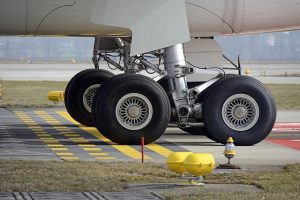
Landing gear systems consist of more than just wheels; they typically require shock absorbers as well. Shock absorbers are designed to absorb and dampen the force to which landing gear systems are exposed during takeoffs and landings. While there are different types of shock absorbers used in landing gear systems, oleo struts are one of the most common.
What Are Oleo Struts?
Oleo struts are pneumatic- and hydraulic-based shock absorbers that are used in landing gear systems. Also known simply as shock struts, they are used in large commercial jets as well as smaller jets and airplanes.
Airplanes require shock absorbers to both cushion the impact of landing and to prevent bouncing off the runway. If an airplane bounces as it touches down on the runway, the pilot may lose control over it. Oleo struts are shock absorbers. They use both air and oil to absorb shock and, thus, promote safer takeoffs and landings.
The air used in oleo struts typically consists of nitrogen gas. When compared to standard air, nitrogen gas is better protected against corrosion. Some oleo struts still use standard air, but most of them use nitrogen gas for protection against corrosion.
How Oleo Struts Work
Oleo struts are both pneumatic and hydraulic. They are pneumatic in the sense that they use air, and they are hydraulic in the sense that they use oil (or hydraulic fluid).
Most oleo struts feature a piston. The piston connects to a landing gear wheel at the bottom and an oil-filled cylinder at the top. There’s typically a small hole in the middle of each oleo strut.
Oleo struts contain both air and oil. The ratio of air to oil in an oleo strut, though, will vary depending on the amount of force to which the airplane’s landing gear system is exposed. When an airplane initially touches down on the runway, the air will compress. As the air compresses, it will absorb and dampen the force to which the landing gear system.
As previously mentioned, all oleo struts contain air and oil. The air is found near the top of an oleo strut, whereas the oil is found near the bottom. Landing will cause the oil to press against the air-filled cylinder. The compressed air will then absorb the shock of landing.
In Conclusion
Oleo struts aren’t ordinary spring-based shock absorbers. While they do, in fact, function as springs, they leverage both air and oil.



